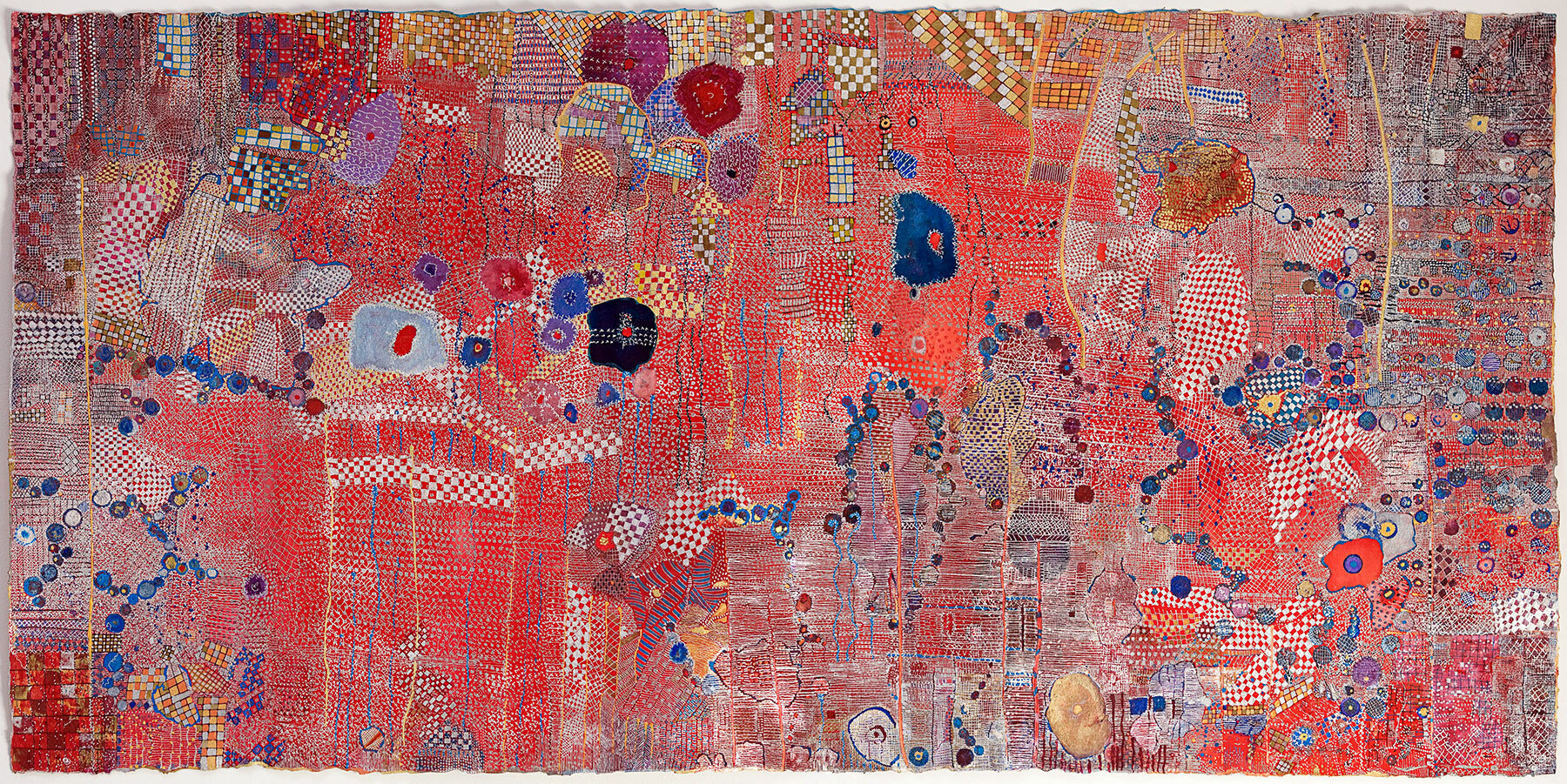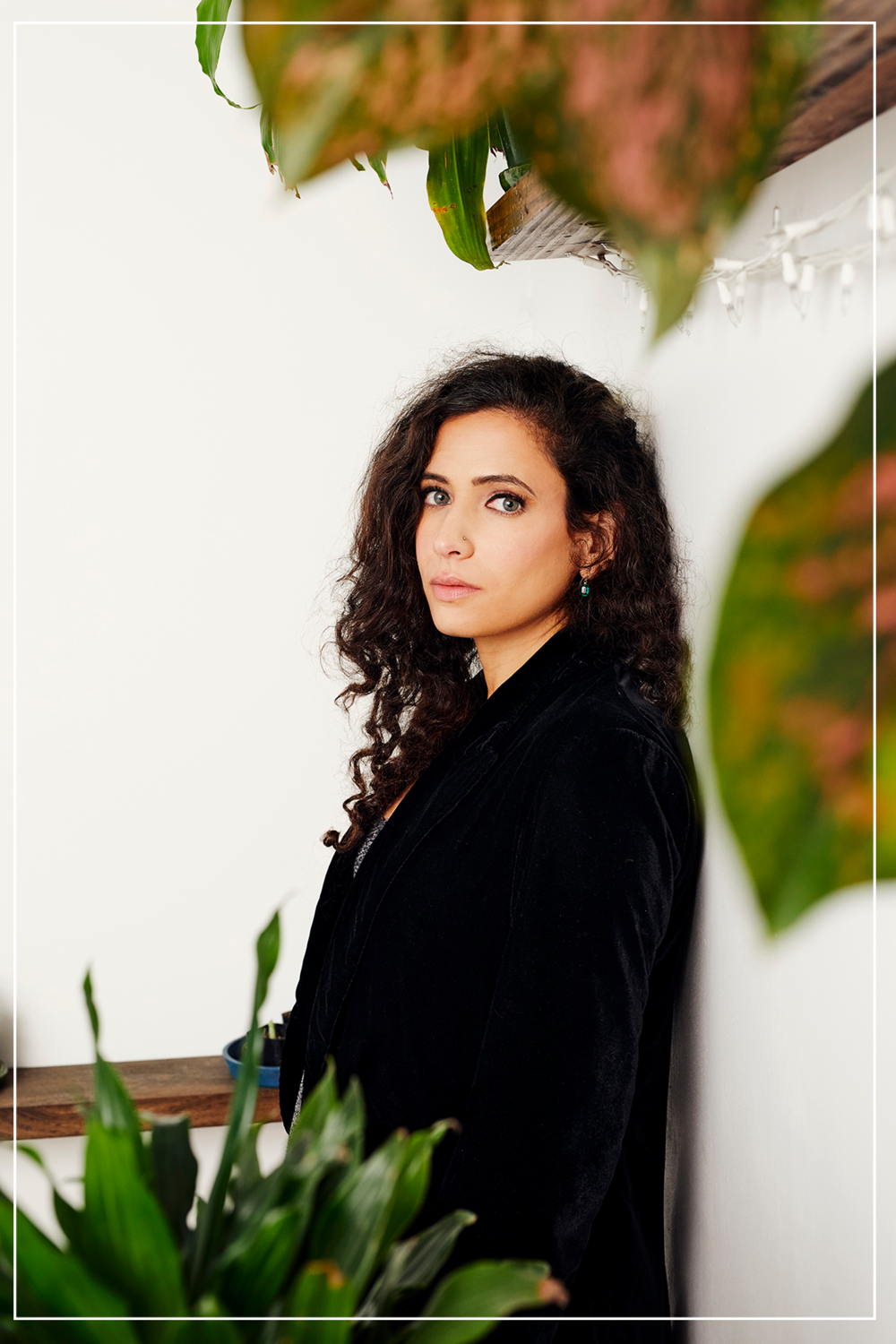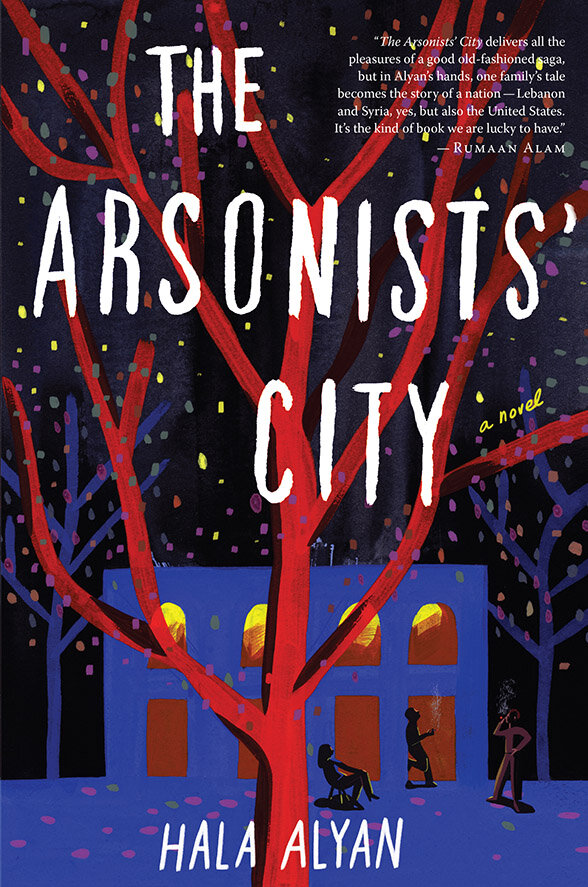“Untitled” by Beirut native Huguette Caland.
 <
<
The Arsonists’ City, a novel by Hala Alyan
Houghton Mifflin Harcourt, March 2021
ISBN 9780358126553
Rana Asfour
“Tonight the man will die … the city already seems resigned to it.”
Novelist Hala Alyan kicks off The Arsonists’ City with a prologue that unspools a decades-long multigenerational family saga. The killing is an assassination in revenge for another committed for no reason “other than that people were hurting people.” The year is 1978 and the capital city of Lebanon, Beirut, is three years into the throes of a raging civil war sparked by battles between Palestinian and Christian militias and other actors that will last another twelve years, claiming more than a hundred thousand lives. In response, Syrian army personnel have set up shop in the city. They will “overstay their welcome by about three decades” before finally withdrawing in 2005. Amongst all the destruction and uncertainty, two people — rising Syrian theatre actress Mazna who harbors dreams of Hollywood, and the flamboyant wealthy Lebanese Idris — are falling in love. Threatened by the assassination and fearing Idris may be the next target, the couple marries and set off to “Amrika” in pursuit of the American Dream.
Decades rumble by. The year is 2018. Ava, a biologist married to Nate with whom they share two children, is Mazna and Idris’s eldest daughter. She receives a phone call from her mother fuming at Idris’s decision to sell the family’s defunct ancestral home in Beirut. She is demanding that her eldest “sensible” daughter travel with them to Beirut in the summer and convince Mimi, Ava’s younger brother, who lives in Austin, to join them. Together with their younger sister Naj, in Beirut, they are to help Mazna save “the last family house that belongs to us.” Despite finally succumbing to her mother’s wishes, Ava remains sceptical of her motives to rescue the property; for one, Mazna hasn’t set foot in Beirut for close to thirty years, and besides, the only names on the deed are those of Idris and his sister Sarah, who never left the city.
By the time all the Nasr members reunite in Beirut, readers have a somewhat clearer mosaic of who they are as individuals, their relationship with each other and their legacy, as well as their feelings about returning to Beirut: eldest Ava who is juggling a shaky marriage as well as the demands of motherhood, and whose career is caught up between feelings of inadequacy and frustration for not fitting in with her white American husband’s Hampton friends, where she feels “outside of life instead of in it” and guilt for being a “fake Arab” when it comes to her family’s heritage; thirty-five-year-old, “almost rock star” Mimi, who manages a restaurant in Austin where he lives with his girlfriend Harper and performs in an obscure rock band, “in which he is the oldest by a decade,” and hasn’t laid eyes on his grandfather’s house in twenty years. Nevertheless, despite the pressures of contending with his mother’s outright condescension of Harper’s middle class background, his father’s disapproval of his money-draining hopeless musical pursuits, and his resentment of his sister Naj’s celebrity status, he discovers that his childhood summers with his grandfather and “a city he knows only in heat” remain etched in his memory.
“The house is over a hundred years old, and the rooms are sunny and narrow. The house isn’t just a house – it’s a House. After all of Beirut’s grubby buildings, Mazna hadn’t expected something so hidden, so pretty. This is like traveling back in time, the courtyard in front tiled, a canopy of branches overhead, the peaked roof.”
It is Naj though, the famous pop singer fronting “quiet but ferocious nods to queerness” that feels most attached to the ancestral home since relocating to Beirut and the only one, besides Idris, to attend their grandfather’s official funeral. Perturbed at the family’s descent upon a city she has come to regard as keeper of her secrets, deeply missing her grandfather, and grappling with the painful memories after a chance meet up with a former girlfriend, she feels that the family’s visit could not have come at a worse time.
Readers at this point are treated to Mazna and Idris’s backstory that will lift the lid on Mazna’s decision to put a distance between her and a city she once adored. With that, the cartoonish caricature of a stereotypical elder Middle Eastern couple, portrayed affectionately bickering at the start of the novel, splinters at the seams, exposing a gritty tale of a marriage that has had to weather its fair share of adversity, pain and sacrifice not only to assimilate and persevere but also to thrive and flourish on foreign soil.
And so ultimately it comes as no surprise that a few days into the family reunion, the fragile bonds between its members begin to unravel and all the old resentments, secrets and lies simmering beneath the surface threaten to implode, as the family quickly settles into a routine that reminds the siblings uncomfortably of their childhood. That said, it becomes interesting to note that while the novel progresses along with shifting perspectives and plot twists that contribute to the richness of the story, bringing to the forefront a tumultuous time in Lebanese history, it is the familial bonds, fraught as they are, that sustain the characters and bring them back together again.
Alyan’s decision to anchor her sophomore novel around an heirloom is not a new one. Her debut novel Salt Houses, published in 2017 and winner of the Dayton Literary Peace Prize and the Arab American Book Award, follows the story of four generations of a fictional Palestinian middle class family, the Yacoubs, in which Alyan masterfully conveys the sentimentality of objects, particularly within displaced immigrant communities, as symbols for invaluable stories of family history, memories and places that no longer exist.
All aside, it is the city of Beirut that vies for and takes center stage as a “city of multiple reincarnations” mired in contradictions and paradoxes. Beirut is the maternal city welcoming its prodigal children returning to its fold. It is as well a sanctuary for refugees fleeing from a seventh year of civil war in neighbouring Syria. It is the place where the absence of architectural planning has rendered the landscape an amalgam hodgepodge in which state of the art luxury apartments built with Gulf money crop up side by side with “scruffy neighbourhoods with plain facades and crumbling architecture.” It is a city that boasts art galleries, film and music festivals, gay bars, overpriced teashops, yoga studios and Uber. A secure city where “friends don’t lock their apartments even if it isn’t always safe” due to car bombs, invasions, and roads blocked by week-long protests.
With one foot in the East and another in the West, the author insists on portraying a city intent on pushing back against its infamous reputation as one where everything is fleeting, no one is there to stay, and no one is quite sure where they belong. In one interview Alyan described the city as “fragmented in the imagination: either exotified or fretted over, a place condensed into devastating headlines. But those who love that city (and country) know it to be brimming with contradictions and capable of holding multiple, at times painful realities and truths.”
Novelist and poet Hala Alyan.
 <
<
I shed my first tears for a city when as a young Jordanian I was about to leave Beirut after four years at the American University of Beirut (AUB). In my memory, Beirut nestles in a precious compartment, one from which I retrieve the images of my first rock concert, my early explorations into the limits of my independence and the first intake of breath when I opened my eyes to an expansive view of the Mediterranean from my bedroom window. Beirut was also the place where for the first time I learned about navigating through a city peppered with roadblocks and checkpoints run by an occupying army. I got my first taste of political unrest when my dorm building shook and my windows shattered following an explosion that rocked the campus, bringing down its landmark College Hall early one dawn — my first awakening to the history and politics of an entire region I belong to.
Ironically, The Arsonists’ City ends in 2019, just a year shy of the tragedy that catapulted Beirut back into worldwide headlines when on August 4, 2020, a staggering 2,700 tons of ammonium nitrate stored at Beirut’s port exploded, causing, by most estimates, at least 210 deaths, 7,500 injuries, and US$15 billion in property damages, bringing Beirut’s economy to a standstill at its worst possible time, when massive inflation and Covid are the order of the day.
As the novel crescendos to its dramatic vibrant finale, the author covers swathes of de jour global and region-specific issues regarding identity and legacy, immigration, sexuality, race, feminism, and colonialism. The result is a new understanding of family, home and belonging and an appreciation of humankind’s capacity for compassion, healing and perseverance. The Arsonists’ City is a character-driven novel, intricately structured and layered with suggestions from the author’s own life as a six-year resident of Beirut, when she was a student at AUB; as an immigrant who travelled with her parents from Kuwait to the US after Saddam Hussein’s invasion of the country in 1990 cost them their home; and as a clinical psychologist, trained in the art of bringing together fragmented experiences in order to create a cohesive picture, rendering the narrative at once familiar and universal.
Hala Alyan is also a poet with four award-winning collections to her name, most recently The Twenty-Ninth Year. Her poetry collection Atrium was awarded the 2013 Arab American Book Award in Poetry, while her collection Hijra was selected as a winner of the 2015 Crab Orchard Series in Poetry. Therefore, it comes as no surprise when the prose reads lyrical in places contributing to the assumption that given the length of The Arsonists’ City at just under 450 pages, it is in fact one writer’s indulgent, languid ode to a city she carries much affection for and a network of people that make a place far more than its architecture and infrastructure ever will. And in the few places where the novel’s electric charge may wobble or its structure shouldn’t work and yet does, that too seems in tandem with a place where nothing works as it should and yet people succumb, lulled by the magic and the promise.
And then they return time and time again even when it all goes up in flames, because “Fuck it, it’s Beirut.”
<


 <
<